Managing a project is about identifying the tasks that need to be done. But, that’s just the first step. To deliver a project, you’ll need to get project tasks done. A team task management software simplifies this by helping you and your team identify, organize, and get tasks done.
When it comes to choosing a task management app, you are spoiled for choice. To reduce this overwhelm, we have created this resource to help you pick the right tool for task management.
In this article you’ll learn:
- What is task management?
- Differences between task management and to-do lists
- Why do you need team task management software?
- How to choose a team task management software?
- The best 10 task management software tools
If you want to directly skip to the tools, here’s the list of the top online task management solutions. Click on the name of the tool to learn more about it.
| Tool | Price per user per month | Pros & Cons |
|---|---|---|
| Toggl Plan | $9+ | ✔️ Visual task boards ✔️ Recurring tasks ✔️ Plan tasks with timelines ✔️ Plan team workloads |
| Trello | $12.50+ | ✔️ Visual task boards ❌ Planning features |
| Basecamp | $99 (unlimited users) | ✔️ To-do lists ✔️ Team chat ❌ No planning features |
| Todoist | $5+ | ✔️ Task lists ❌ Planning features |
| TaskLog | $5+ | ✔️ Task lists ✔️ Ideal for freelancers ❌ Team tasks |
| MeisterTask | $4.19+ | ✔️ Visual task boards ✔️ Recurring tasks ❌ Team planning features |
| Sendtask | – | ✔️ Simple task management ❌ Under development |
| Notion | $8+ | ✔️ Visual task boards ✔️ Team wiki ❌ Planning features |
| Nifty | $49 (10 users) | ✔️ Simple task management ✔️ Team chat ❌ Planning features |
| Backlog | $35 (30 users) | ✔️ Agile project management ✔️ Ideal for software teams ❌ Complex |
What is task management?
Task management is an essential part of project management. It enables you to break down the project into small, achievable tasks and measure their progress throughout their lifecycle.
Task management helps teams reduce the overwhelm, boost productivity, and reward small wins on the completion of key milestones.
Task management consists of three primary activities:
- Tracking Project Tasks: You keep a tab on task completion. You can use kanban boards or set up customized project workflows to track the task progress.
- Delegating Tasks: You assign tasks to individuals or a team(s). Task delegation allows managers to increase efficiency and improve collaboration.
- Assigning Task Deadlines: Depending on the project timeline, task complexity, and estimated time required, you assign a deadline to each task. If necessary, you can also set up reminders to notify the team of the upcoming deadline.
Task management vs to-do lists
The confusion between task management and to-do lists perhaps stems from the similarity between checking-off a task off the list after its completion. But task management is quite comprehensive compared to a to-do list.
To-do lists are the simplest form of task management. You enlist the tasks, errands to run, or anything you’d like to complete during the given day, and that’s it. You might rearrange the items, but they don’t go any granular than this.
Task management, on the other hand, is concerned with other intricacies of project management. Some of the complexities in task management include:
- Deadlines: Assigning a delivery deadline allows individuals or teams to prioritize their work.
- Resource Availability: By viewing resource allocation and workload distribution you can optimize task delegation.
- Task Dependencies: By visualizing task dependencies, you can prioritize the tasks that would speed up project completion.
Why do you need team task management software?
A task management system simplifies your team’s task workflow.
Here are five reasons a team task management software can be of immense help for managing projects:
1. Capture, organize and prioritize project activities
Task management software helps you keep a record of the identified tasks. In addition, it helps you organize project tasks according to project milestones, and schedule them based on priority. Depending on task dependencies, you can then plan out a project timeline.
2. Plan work and team schedules
Based on the project timeline, you can use a task planning app to plan and schedule your work.
Identifying team members and assigning tasks helps you distribute work. The team schedule visualizes individual tasks and workloads, which allows you to view who is overworked and who can cram in one more task.
3. Create a project information hub
A task management application provides a platform to store all project-related information in one place. While creating new tasks, team members can include additional information (external links, resources) and attach files under each task.
Users can also create a project wiki to centralize essential documentation and information required for the project.
4. Track project progress
Most task tracking apps come with multiple views to visualize project progress. Two of the most common views include the kanban board and the Gantt chart/timeline view.
The kanban board consists of a workflow to visualize task progress. Users can move tasks across different boards as they are working on them.
The Gantt chart shows the project/task schedule over a timeline. You can view each task’s start and end date, duration, current progress, dependencies, etc. in an instance.
On the task level, team members can collaborate with the team, discuss potential issues, and get stakeholder approval.
5. Meet deadlines
A milestone is achieved when all the pre-agreed tasks are completed by a given deadline. That’s why team members need clear visual cues about upcoming milestones and deadlines. Task management software tools help the team get an overview of the progress made towards a milestone.
How to choose a perfect task management software?
Before we look at the 10 best task managers, let’s understand how to pick a solution that will work for you. The following points can help you evaluate task management alternatives:
1. Infrastructure & availability
Security and workflows dictate the infrastructure you’ll need for a project task manager. In addition, the infrastructure you choose will also decide when and how the task management system is available.
- For personal task management, daily task management software will work just fine. It doesn’t have to be fancy-schmancy. As long as you can check off the to-do list at the end of the day, it’s served its purpose.
- If you are an in-house team, you can use on-premise software that works on the company intranet. The shortcoming of this infrastructure is that you can’t access the application outside company premises via the internet.
- On the other hand, with a cloud-based task manager, you can access the software via a smartphone or a computer as long as you have a working internet connection.
2. User interface and user experience (UI/UX)
A task organizer is always a means to an end. In other words, you don’t want your team to spend more time updating tasks progress than actually doing them.
Complex task management solutions often slow teams down. That’s because you have to spend time onboarding your team, teaching them about the software, and making sure they use it the right way.
And, sometimes team abandon using a tool, simply because it’s too complex to use.
3. Key features
Task details: The task planning app should allow you to add sufficient information about what needs to be done. That way, the team members responsible for doing the task have everything they need to complete the task.
This includes file attachments, rich text task description, task deadlines, etc.
Customizable task workflows: Each team works in a different way.
A design team has to brainstorm, ideate, create and get a creative approved before it goes live. On the other hand, a software team may take an entirely different approach.
The task planning tool should be flexible to work with your workflow. Or, you’ll have to spend even more time adapting to the tool’s workflow.
Task collaboration platform: Often team members need to work together on tasks. A task manager needs to have the ability to:
- Assign tasks to multiple team members.
- Share task notes and comments to discuss details and manage approvals.
- Attach files that may be needed to complete the task.
- Keep stakeholders updated with the project progress.
Task schedule overview: It’s immensely helpful if the task manager offers a timeline view. This way, you can track tasks, understand task dependencies and bottlenecks, phase completion in a glimpse. You will also be able to visualize resource allocation.
4. Integrations
The task management platform should compensate for the missing features via third-party integrations. The most common integrations include time tracking, calendar, billing, scheduling, and communication apps.
5. Budget
Money is a big factor when it comes to choosing a task management app. That’s because most tools charge a monthly fee per user. So, you’ll need a budget for all the team members you plan to onboard.
Top 10 online task management software tools
Now that we know what to look for in a project and task management tools and how to choose one, let’s look at the top ten task management platforms for teams.
1. Toggl Plan
Toggl Plan is one of the simplest project and team task management tool for many reasons. While it comes with everything you need to manage tasks, there’s practically no learning curve involved.
Plan tasks on a timeline
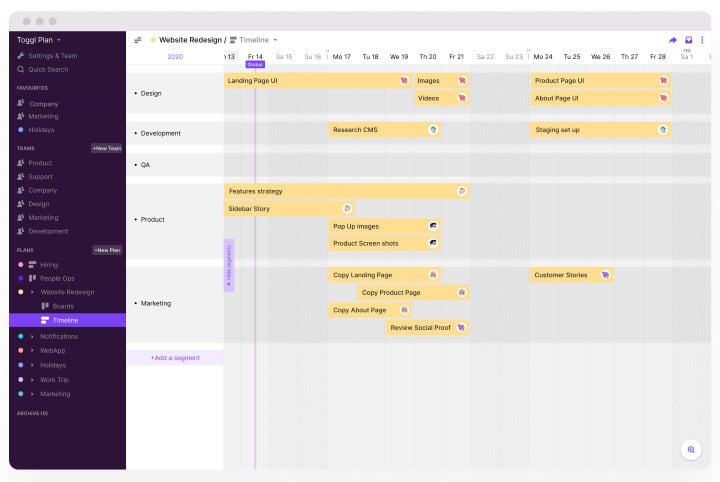
Planning tasks is super-easy with Toggl Plan. To get started, just add tasks to the project’s timeline. Then, schedule tasks based on deadlines and resource availability.
The timeline gives a clear overview of what’s being done and what needs to be done.
Create custom workflows with boards
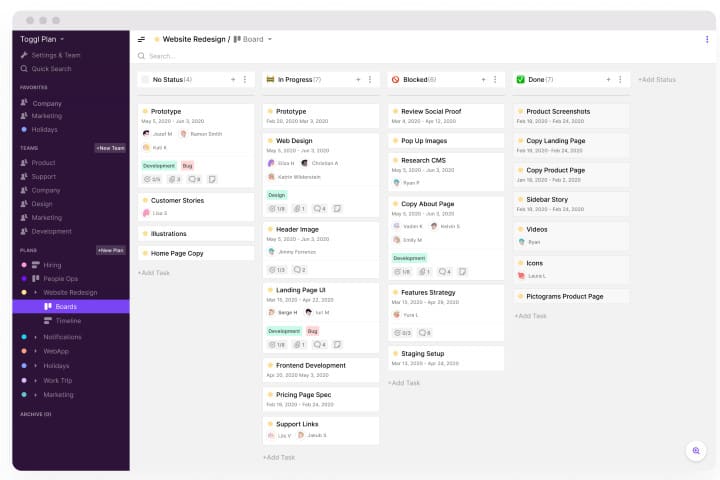
While you can manage tasks directly from the timeline, Toggl Plan also comes with a boards view. You can customize the board based on your workflow.
And, your team members can simply drag and drop tasks from to-do to done.
Keep everything you need in one place

With Toggl Plan, you can keep all your project information in one place.
You can add all the task details in one place with a rich text task description, task checklist, and file attachments. Task assignment is easy and you can make multiple team members responsible for a task.
Also, tasks can be assigned to multiple team members. Team members can then discuss and collaborate on the task by adding comments.
Recurring Tasks & Time-Tracking
With Toggl Plan, you can also plan and manage repetitive tasks. Recurring tasks can repeat daily, weekly, monthly, or every year.
In addition, you can improve your team’s productivity by integrating with Toggl Track for time-tracking.
Pricing
- Toggl Plan is free for solo users and includes unlimited tasks and projects.
- The team plans starts at $8 per user, per month, paid annually. You also get additional features like the annual view, custom colors, and multi-assign tasks.
2. Trello

Trello is a kanban-based project and task management tool. Known for its simplicity, Trello is to manage individual goals as well as team projects.
Features
- Visual task management with kanban boards.
- Users can add subtasks, due date, attach files, include task description, leave comments, and assign it to multiple users.
- Create customized workflows to suit your project requirements.
- Automate task management through rule-based triggers, calendar, and due date commands.
Cons
- Doesn’t offer the Gantt chart or timeline view.
- Users can’t visualize task dependencies.
- The absence of timeline and calendar views restricts its utility for complex tasks.
Pricing
- The free plan lets you create ten boards and is useful for individuals or small teams.
- The paid plans start at $12.50 per user, per month that offer unlimited team boards, powerful automation features, and better support.
3. Basecamp
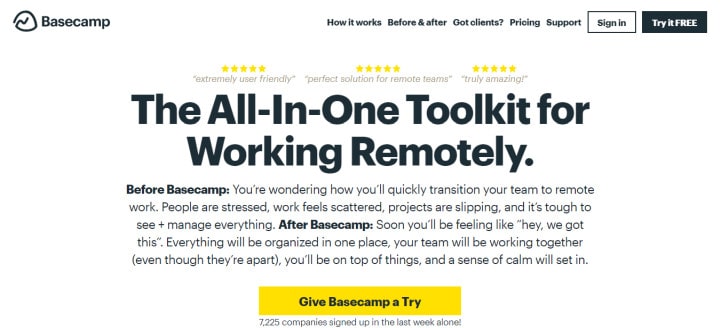
The first thing you’ll notice with Basecamp is that its interface is different compared to contemporary task management apps. It segregates the message board, to-do list, chat, and files into different modules under each project or team.
Features
- Create task lists in the to-dos section. You can assign tasks, add notes, attach files, set due dates, and leave comments.
- Visualize project progress using Hill Charts. It’s a native Basecamp feature that provides a macro perspective of the project.
- Centralize project files at a single location.
Cons
- Doesn’t offer kanban board and timeline views.
- Very rigid when it comes to customizing options.
- The lack of phases and milestones makes it challenging to track project progress.
- Expensive for smaller teams.
Pricing
- Doesn’t offer a free plan.
- After the 30-day free trial, you are charged a $99 per month flat.
4. Todoist

Todoist is a simple yet powerful task management tool. The tool brings together the best of a simple to-do list and the complexities of a task management app.
Features
- Create a task list and order it by task priorities.
- Categorize tasks by tags, projects, or due dates. Prioritize important tasks by projects, labels, or filters.
- Automate recurring task creation based on their frequency.
- Use ready-to-use templates to set up a list of tasks.
- Comprehensive third-party integrations.
Cons
- Although the app is easy-to-use, setting up projects can be complex in the beginning.
- Essential features like file uploads, comments, and calendar sync are offered under premium plans.
- Not a comprehensive solution to manage complex projects or tasks.
- The absence of the timeline view makes it difficult to track project progress.
Pricing
- The free plan accommodates 80 projects with five users per project. Useful for individual projects.
- For reminders, activity logs shared team inbox, and user roles, subscribe to their business plan starting at $5 per user, per month.
5. Tasklog

Tasklog is a nifty work management software for freelancers. It comes with all the essential features to help freelancers boost their productivity and manage tasks and time effectively.
Features
- Built-in time tracker, timesheets, and Pomodoro timer.
- Create and manage tasks and projects. Assign labels. Create reusable templates.
- Set up an hourly rate. Track your time and earnings per project to identify crucial clients.
- Use the dashboard to analyze productivity, time per project or client, profitable projects, and clients.
Cons
- Not a powerful for teams or complex projects.
- Lack of third-party integrations.
- Doesn’t offer kanban board or timeline views.
Pricing
- The app offers a free 7-day trial. The individual plan costs $5 per month.
- The basic plan for teams starts at $50 per month for 50 users.
6. MeisterTask

MeisterTask is an intuitive project task management system for individuals and teams. The tool is primarily kanban-based, which makes it easy to track tasks.
Features
- Import your data directly from Trello and Asana.
- Visualize task dependencies to identify bottlenecks. Users receive notifications when these bottlenecks are resolved.
- Set up recurring tasks.
- Add custom fields depending on the nature of the project.
- Provides built-in time tracker.
Cons
- Not suitable for traditional or complex project management.
- Doesn’t offer timeline and calendar views.
- Users have faced difficulties with setting up customized workflows.
Pricing
- The free plan allows you to add three projects with limited integration capabilities.
- The pro plan starts at $4.19 per month, billed annually.
7. Sendtask
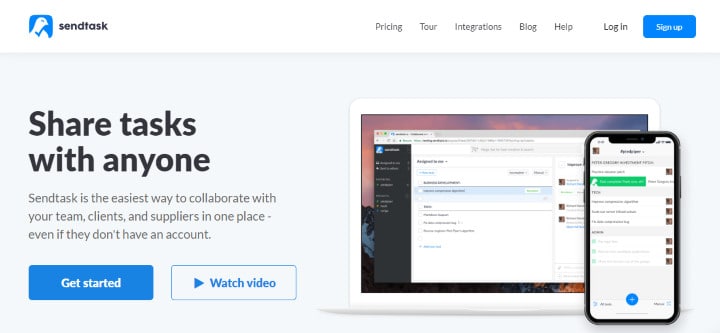
Sendtask is an under-development task management tool known for its flexibility. The biggest advantage while collaborating is that the collaborators don’t need a Sendtask account to work on the project.
Features
- Set up tasks and subtasks, assign tasks, add followers, upload files, set due dates, and auto-reminders.
- Create recurring tasks.
- Useful for individuals and smaller teams.
Cons
- Doesn’t have a kanban board and timeline views.
- You can’t assign tasks to multiple people.
- Limited integrations.
Pricing
- Sendtask is still in beta and free to use.
8. Notion

Notion is a workspace suite that offers some features for project and task management. It is useful to set up a content repository, manage tasks and projects, and works as a powerful note-taking application.
Features
- Manage tasks using document boards, calendars, lists, and tables.
- Set up a wiki to store project documentation.
- Create customized workflows.
- Offers a truly rich-text editor that lets you embed 50+ apps inside Notion pages.
Cons
- Notion’s expansive feature set itself can make the app clunky to use.
- Lacks intuitiveness that comes due to the comprehensiveness of the product.
- Doesn’t offer timeline views and other task management features offered by traditional task management apps.
Pricing
- The free plan is useful for solo users.
- The team plan starts at $8 per user, per month and offers better collaboration options.
9. Nifty
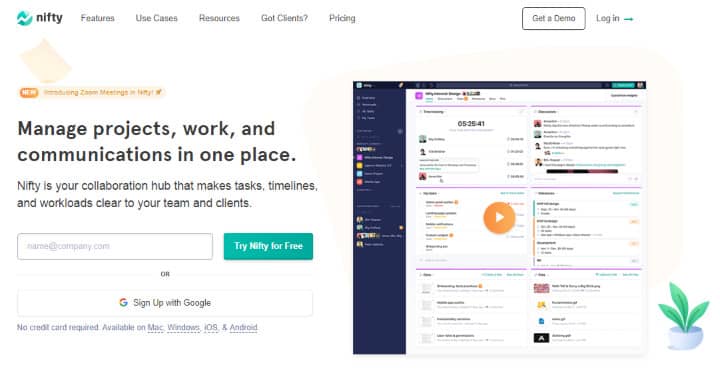
Nifty is a team collaboration software that also offers a team task manager. The app’s UI is similar to that of Basecamp. You can customize the modules to suit your project requirements.
Features
- Kanban and timeline views provide a better way to track tasks.
- Automate task allocation by assigning a task list to a user. This automatically assigns every new task to the list to the default user.
- Set up recurring tasks.
- Convert task lists into milestones and map out dependencies.
Cons
- It relies on Zapier to facilitate some integrations, which can get expensive.
- Comes with a learning curve.
- The interface can get crowded.
- Time tracking and reporting features cost an additional $20 per month for basic plans.
Pricing
- Nifty offers a 14-day free trial. The basic plan starts at $49 per month that supports ten users.
10. Backlog

Backlog offers project management, bug tracking, and robust task management features. That’s because it’s primarily for software developers.
Features
- Visualize tasks and schedules using kanban boards, burndown charts, and timeline views.
- Integrate with Git and SVN to manage tasks and source code.
- Assign guest roles to freelancers, clients, and vendors for better collaboration.
Cons
- Users have reported issues with the task management process.
- The mobile app is not as powerful as its web version.
- Provides fewer integrations considering the product’s scope.
Pricing
- The free plan allows ten users and one project.
- The basic plan starts at $35 per month for 30 users and five projects and includes 1 GB of storage.
How to pick the right task management tools for your team?
Effective task management determines the success of a project.
Picking a project task management system isn’t always easy. That’s because there are so many parameters and options.
The best way is to weigh the features and cons of each tool and shortlist the ones that fit your budget. And then try out 2-3 solutions. Finally, go for the one that’s intuitive and easy-to-use.
As you’re evaluating, do give Toggl Plan a try.
It comes with all the essential task management features you need. But, critically, there’s absolutely no learning curve. In fact, your team will love using it every day.


